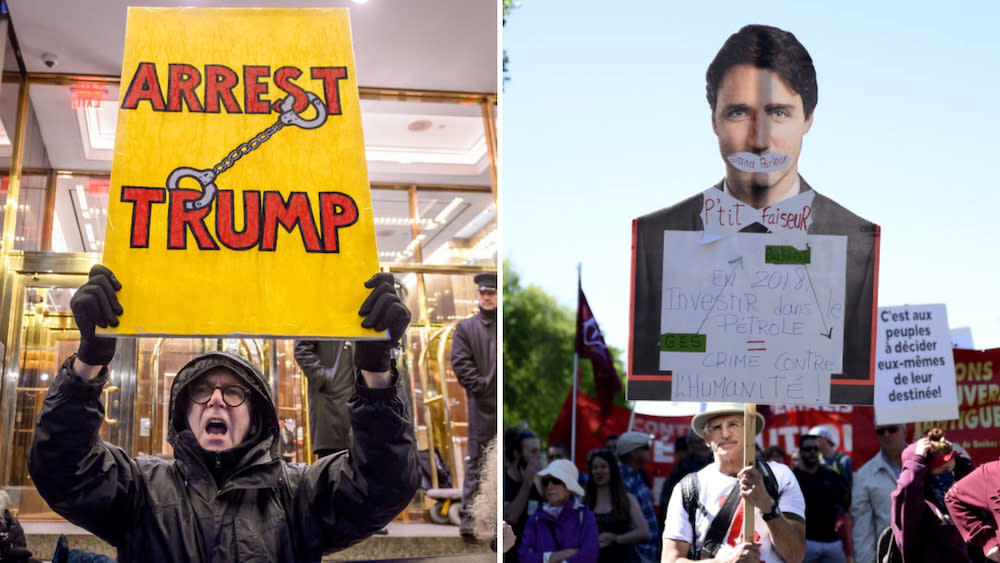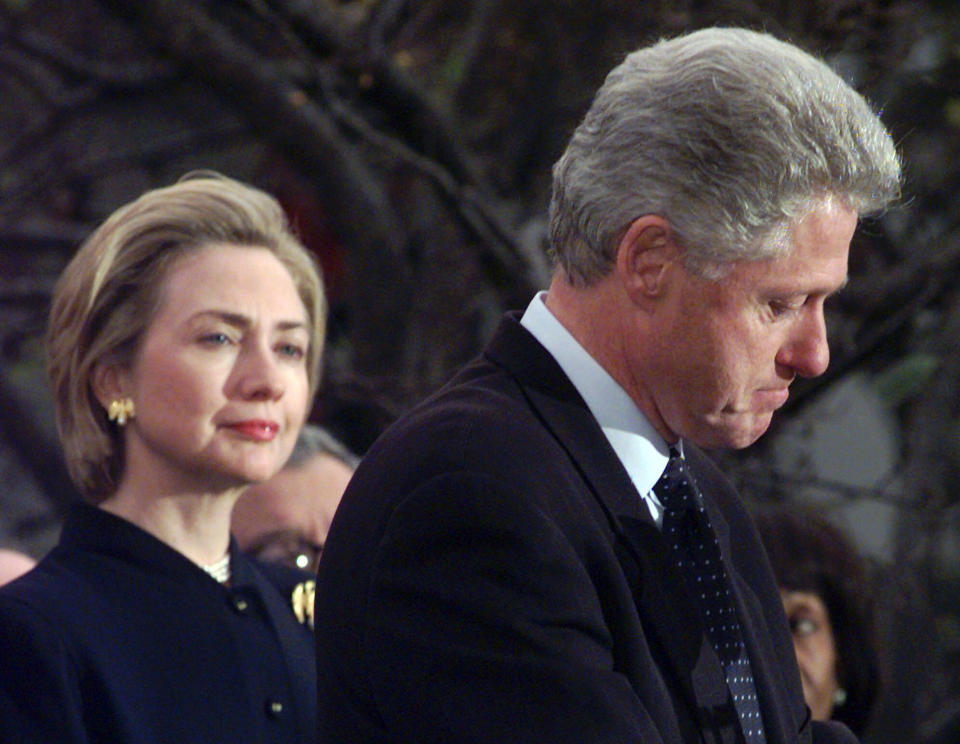Canada vs. U.S.: Will Trudeau or Trump lose their leadership first?

With Canada due for an election in 2019 and the U.S. due for one in 2020, voters in both countries will soon have to decide who to cast their ballots for.
But for the present, a lot of the dialogue around both countries’ governments seems centred less on who to elect as leader and more on how to prosecute the ones in office now. On Feb. 27, testimonies in Canada and the U.S. by former Canadian Attorney General Jody Wilson-Raybould and former Donald Trump lawyer Michael Cohen challenged the credibility of both countries’ leaders.
Prime Minister Justin Trudeau has been accused of political interference in the justice system based on allegations he pressured Wilson-Raybould to drop criminal charges against SNC-Lavalin, a prominent lobbyist, and then demoted her when she refused. President Trump was suspected, among other things, of colluding with Russia in the 2016 U.S. presidential election and of obstructing the FBI’s investigation into that alleged collusion.
While special counsel Robert Mueller’s investigation into those matters did not provide evidence of collusion, the question of whether Trump committed obstruction of justice might still be on the table.
In both countries, vocal minorities are calling for the leaders to be removed from office. Thousands of Canadians have signed online petitions demanding Governor General Julie Payette “impeach” Trudeau. In the U.S., voters are urging the House of Representatives to do the same.
So how is this done in Canada compared to the United States? And in which country is a leader more likely to leave office by some process other than defeat in a general election?
The mechanisms of removal
John McAndrews, a researcher of Canadian and U.S. politics at the University of Toronto, says one of the key differences between how leaders can be removed in Canada compared to the U.S. is that here, there are non-judicial ways of doing it. In America, impeachment is a matter of criminal law.
“We should think about impeachment as being akin to being charged with a crime,” McAndrews says. The lower house, the House of Representatives, impeaches a president by charging him or her with a high crime like treason of bribery.
“Then action shifts to the Senate, and it’s the Senate that convenes itself kind of like a court. A trial proceeds and here the decision rule is not simple majority, it’s two-thirds majority.”
If two thirds of Senators vote to convict the president of his or her crimes, the president is, theoretically, forced from office.
In Canada, the official process for removing a government — because in Canada’s parliamentary system, voters elect a government, not a prime minister — involves a vote of no confidence in the House of Commons.
“The House of Commons can dump a government for any number of reasons…because they don’t like the policies the government is pursuing,” McAndrews says.
“So in theory, the Canadian Constitution permits the House of Commons to withdraw its confidence in the government, and then the government is gone, whether there’s evidence of a crime or anything like that.”
If the vote passes, which usually relies on the government in power having a minority of the seats in the House, the governor general will either call an election, or appoint another party to lead the government.
However, anyone familiar with the Harper government knows there is a tactic governments can use to delay and avoid a non-confidence vote in the first place: prorogation.
In 2009, facing a likely non-confidence motion by the Liberal and NDP parties, the federal Conservatives under Stephen Harper received permission from then Governor General Michaëlle Jean to end parliament, delaying the non-confidence vote.
By the time parliament reconvened several months later, the threat of a non-confidence motion had dissipated.
It’s a tactic Trudeau’s government could choose to adopt in the face of more high-profile resignations like that of Wilson-Raybould, explains Christian Leuprecht, a Royal Military College professor.
“If the Liberals thought that they might have sufficient defections within their ranks, that they might be in a minority position and possibly lose a vote of no confidence, they may well opt to prorogue parliament,” Leuprecht says.
Both Leuprecht and McAndrews agree, though, that the current government is likely safe from the threat of a non-confidence vote.
“In the case of a majority government here in Canada, nobody expects Andrew Scheer to be able to bring down the government,” McAndrews says. “It would have to come from within the governing caucus.”
The threat of mutiny
Beyond the official mechanism of a non-confidence motion, which doesn’t always result in a change of government anyway, there is another way a prime minister can be pressured to step down. It comes from within his or her own party.
“As a leader you have to maintain the confidence of caucus,” Leuprecht says, citing cases where prime ministers like Pierre Trudeau, Jean Chrétien and Brian Mulroney resigned while in office due to pressure within their party.
“These are all three leaders that, in light of poll numbers of the day, decided the party was better off without them than with them,” he says. In Chrétien’s case, he adds, the prime minister was likely facing a mutiny from a faction of his caucus that was loyal to Paul Martin.
“In the case of a majority government here in Canada, nobody expects Andrew Scheer to be able to bring down the government,” McAndrews says. “It would have to come from within the governing caucus.”
— John McAndrews, Canadian and U.S. politics researcher, University of Toronto
“Jean Chrétien essentially withdrew as prime minister,” Leuprecht says. “But for all intents and purposes he was effectively removed by caucus.”
There also exists a law that allows parties to give their MPs the power to essentially vote to remove a party leader from the head position, even if that person is the prime minister. Michael Chong’s Reform Act passed in the upper house in June 2015, but with the provision that each party can choose at the beginning of a new parliament whether it wants to adopt the law.
Under this law, Leuprecht says, a party leader could theoretically “walk in in the morning as Prime Minister and by lunch time you could be sitting as a back bench member of parliament.”
The Liberal Party has not adopted Michael Chong’s Reform Act, however.
Removal is rare, but less so in Canada
Whether by accusations of a crime, a loss of confidence or the threat of mutiny, each method of officially or unofficially removing a leader takes time, and each depends on many moving parts.
In the U.S., impeachment simply means the president is accused, but not convicted, of committing a high crime. No president has been convicted of a crime and legally forced out of office through the impeachment process.
Instead, the process of impeachment has tended to have one of two effects. First, it may backfire on the opposition if they appear to overstep their authority, as was the case with President Bill Clinton and the House Republicans in 1998.
Clinton’s approval rating actually rose after the House of Representatives charged him with perjury and obstruction of justice, while voters accused the Republican party of committing an abuse of power.

“A lot of voters looked at that and said ‘You overstepped’ and the Republicans lost some support in that case,” McAndrews says.
Further, Clinton was never convicted of the crimes of which he was accused by the Republicans.
Another possible outcome is that, as was the case with President Richard Nixon, the threat of being convicted of a crime is so great that resigning, and therefore avoiding impeachment and the ensuing trial, becomes the best option.
“Nixon was never actually indicted,” Leuprecht says. “The premise is there is so much evidence against you that if you go away, we will not indict you. So you can pick what fate you want to live.”
Therefore, while several presidents have been impeached, and one has resigned, none have been officially removed office by the impeachment process.
Trudeau is more at risk than Trump, expert says
Canada, in contrast with America’s one presidential resignation, has seen a handful of prime ministers resign while in office.
Prime Ministers Arthur Meighen, John Diefenbaker, Pierre Trudeau, Joe Clark, Paul Martin and Stephen Harper were all at the losing end of either a loss of supply or a vote of non-confidence at some point during their leadership. Some, like Harper, weathered the challenges, while others either resigned as a result of a non-confidence vote, or were pressured to step down by their caucus.
Prime Minister MacKenzie King resigned in 1926 before the opposition had a chance to put forward a non-confidence motion.
“It is easier for leaders in Canada to be removed, whether that be by vote of no confidence or election,” Leuprecht says. “But also by they themselves making the decision to remove themselves for the good of the party and the electoral chances of the party.”
Leuprecht says if there is a time when Trudeau should be especially sensitive to the the polls and the temperature of his party, it is now. Less than a year out from an election, and facing challenges to his credibility, Trudeau is under heavy scrutiny right now.
“The timing couldn’t be worse for the prime minister or any prime minister,” Leuprecht says. “Because it’s just enough time for members of the party to start getting nervous depending on what they’re hearing from their constituents about getting re-elected.”
When Donald Trump leaves office, it could be because he lost an election, because he reached his presidential term limit or because he resigned under the pressure of impeachment. If Canadian political history proves anything, it is that Justin Trudeau’s fate in office is equally unclear and possibly less secure.
And if there’s something else history has proven, it is that if disgruntled Canadians are going to topple the government, it won’t be because they added their names to a petition.


